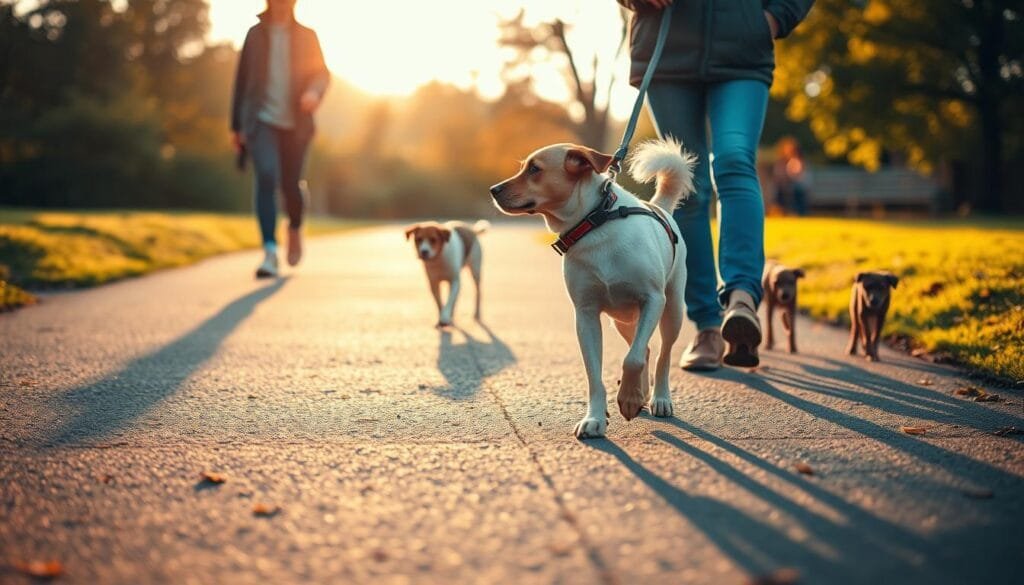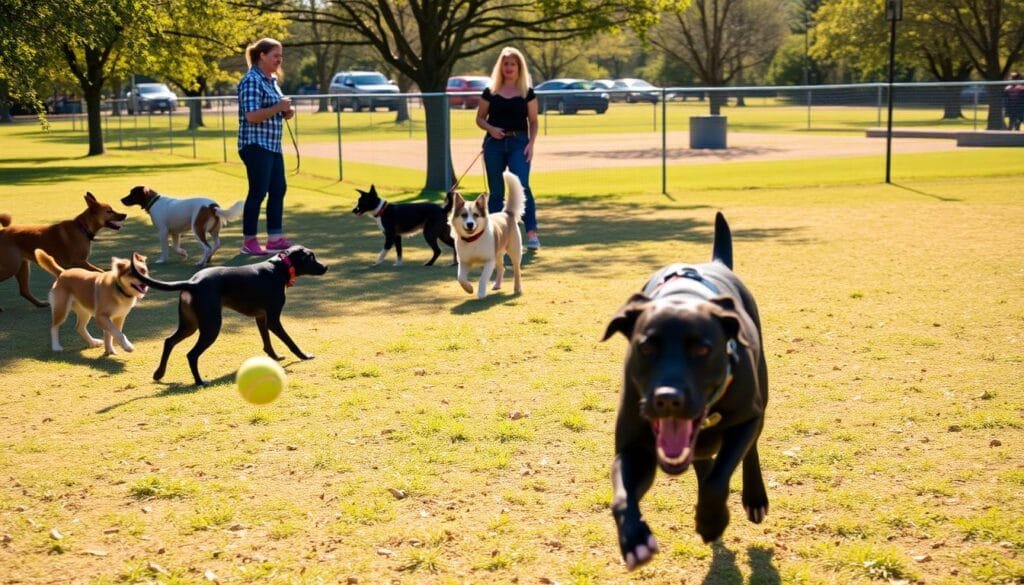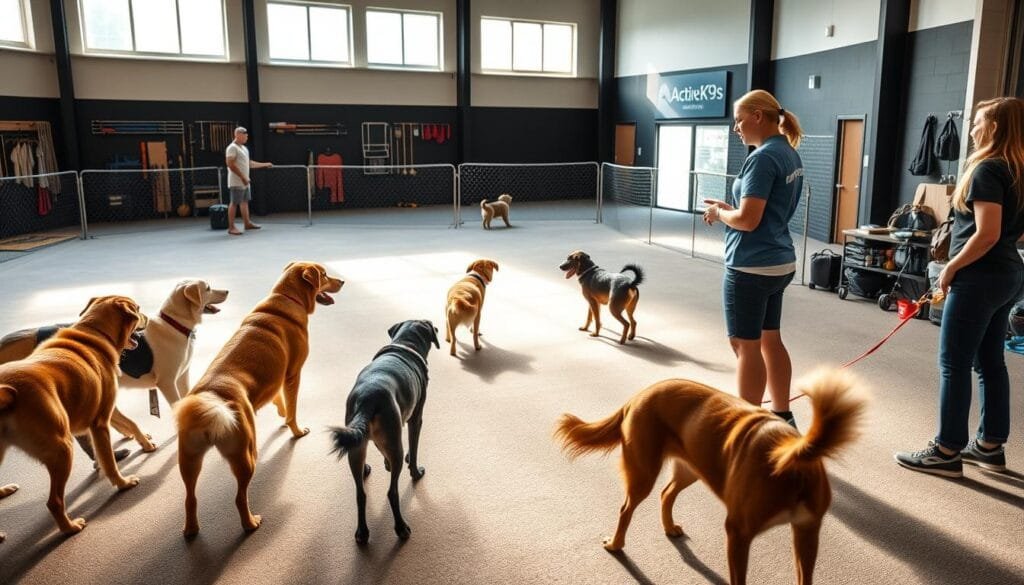Can your dog roam freely without a leash and listen to you instantly? Training a reliable off-leash dog needs more than hope. It requires strategic skills, trust, and clear communication with your dog.
Creating a reliable off-leash dog is about more than freedom. It’s about building a strong, responsive bond that keeps your dog safe and you at ease. We teach dog owners to train their dogs off-leash using proven techniques. These methods build trust, obedience, and understanding between you and your dog.
Every dog can become a trustworthy off-leash partner. Our approach includes gradual training, positive reinforcement, and understanding your dog’s personality. This way, you create a strong connection that goes beyond the leash.
Key Takeaways
- Develop a strong foundation of trust and communication
- Understand progressive training techniques
- Learn safety protocols for off-leash environments
- Build consistent recall and control skills
- Create a deep bond with your canine companion
Understanding the Importance of reliable off Leash Dog Training
Off-leash training turns a regular dog into a top-notch companion. As dog owners, we aim to make our pets obedient and confident in different places adn develop a reliable off leash dog. This training builds a strong bond between the dog and its handler.
Benefits of Having a Well-Trained Off-Leash Dog
A well-trained dog brings many benefits. These go beyond just having an obedient canine Let’s look at the main advantages:
- More freedom for both dog and owner
- Better mental and physical exercise for the dog
- Stronger communication between dog and handler
- More confidence in different places
Building Trust Between Handler and Dog
Creating a well-trained dog takes patience and regular practice. Trust grows with positive feedback and clear communication. Dogs do well when they know what’s expected and get the right guidance. Leash-free behavioural training requires patience and repitition.
| Training Aspect | Impact on Dog-Handler Relationship |
|---|---|
| Consistent Commands | Builds predictability and understanding |
| Positive Reinforcement | Encourages desired behaviours |
| Regular Practice | Strengthens communication skills |
Safety Considerations and Legal Requirements
Off-leash training means being a responsible dog owner. Owners need to know the laws, risks, and safety steps. Safety is key in off-leash training.
- Check local council regulations
- Ensure proper identification and microchipping
- Maintain updated vaccinations
- Practice recall in controlled environments
Essential Prerequisites Before Starting Off-Leash Training
Turning your dog into a trustworthy friend needs careful planning and groundwork. Before starting off-leash training, it’s crucial to lay a strong foundation. This ensures safety and success. Discover how to train your dog to be reliable off leash as thry are on leash.
Creating a responsive dog begins with mastering key skills. These skills build trust and communication. Let’s look at the important steps for effective off-leash training.
- Solid basic obedience skills
- Strong recall command
- Consistent impulse control
- Proven socialisation experiences
Checking if your dog is ready involves looking at their skills and temperament. Not every dog is ready for off-leash work right away. Signs of readiness include:
- Calm behaviour in busy places
- Quick response to commands
- Little reaction to other dogs and people
- Ability to focus on you
Experts suggest a slow and steady approach. Begin by building a strong bond through positive training. Aim to create a dog that naturally wants to stay near and listen to you.
The secret to off-leash success lies in patience, consistent training, and understanding your dog’s unique personality.
Spending time on these early steps will change your bond. It will make your dog a reliable and confident off-leash friend.
Creating a Strong Foundation with Basic Commands
Starting leash-free training needs a solid base of commands and a robust off leash training routine for success.. Dogs need clear, consistent messages to grow independent yet stay connected to their handler.
Teaching your dog to be independent begins with basic obedience. These skills help build trust and understanding between you and your dog.
Mastering the Recall Command
- Start in a quiet place
- Use tasty treats to motivate
- Train in short, regular sessions
- Always praise them for quick responses
“A perfect recall is the difference between a controlled and an unpredictable dog” – Professional Dog Trainers Association
Establishing Reliable 'Stay' and 'Leave It'
‘Stay’ and ‘Leave It’ are vital for leash-free training. They help control your dog in risky situations.
| Command | Purpose | Training Difficulty |
|---|---|---|
| ‘Stay’ | Prevents dog from moving | Moderate |
| ‘Leave It’ | Stops interaction with potential hazards | Advanced |
Developing Distance Control
Developing distance control in dogs is an essential skill that enhances both their training and your relationship with them. It involves teaching your dog to remain at a certain distance from you while maintaining focus and responding to commands.
This skill can be incredibly useful in various situations, from outdoor activities to obedience training. To successfully train my dog to be independent, I must instill confidence and trustworthiness in them, allowing them the freedom to make choices while still adhering to commands.
The first step in developing distance control is introducing the concept of distance gradually. Start with short distances, using a familiar environment where your dog feels comfortable. Utilize positive reinforcement techniques such as treats or praise to reward your dog when they maintain the desired distance.
It’s essential to remain patient and consistent during this process, as each dog learns at their own pace. Incrementally increase the distance over time, ensuring that your dog stays focused and responsive, which builds their self-reliance without compromising their connection with you.
To reinforce distance control, incorporate various exercises that encourage your dog to practice this skill in diverse environments. For instance, try practicing recall from a distance or send your dog to their designated spot and ask them to stay while you move away.
These exercises will not only strengthen their distance control but also foster independence. As your dog becomes more adept at maintaining distance, you’ll notice their ability to make proper decisions in various contexts, leading to a more trusting and mutually respectful relationship.
Lastly, remember that developing distance control is an ongoing journey. Regular practice and training sessions can help solidify your dog’s understanding of commands while allowing them to thrive as independent companions.
As you continue to train my dog to be independent, you’ll find that the bond you create from this training will make your dog more reliable and responsive, ultimately enhancing your shared experiences together.
Mastering distance control is the top goal of off-leash training. Gradually increase the distance while keeping clear communication. Begin with small distances and increase the challenge.
With time and effort, your dog will become confident and independent. They will respond well to your commands.
The Journey to a Reliable Off-Leash Dog

Turning your dog into a reliable off-leash pet takes time and effort. It’s not something that happens quickly. Instead, it’s a journey of building trust and skills.
Every dog starts with learning the basics of training. We suggest breaking this down into stages. This helps build confidence and better communication between you and your dog.
- Start with foundational obedience skills
- Practice in controlled, low-distraction environments
- Gradually increase training complexity
- Reward consistent positive behaviours
The secret to off-leash training is a predictable and supportive learning space. Consistency is your most powerful training tool.
| Training Stage | Primary Focus | Duration |
|---|---|---|
| Initial Foundation | Basic commands | 4-6 weeks |
| Intermediate Progress | Distraction management | 6-8 weeks |
| Advanced Off-Leash Skills | Complex environment training | 8-12 weeks |
Your dedication to making your dog reliable off-leash will change your bond. It brings freedom and understanding to your relationship. Remember, every dog is different. So, be patient and give them the attention they need.
Building Trust Through Progressive Training Techniques
Creating a trustworthy pet needs patience, understanding, and smart training. It’s not just about basic commands. It’s about building a strong, lasting bond to train my dog to be independant and aware.
Trust is key for off-leash training success. Dogs feel secure and know their limits. Our training builds a strong, positive bond between you and your dog.
Positive Reinforcement Methods
Positive reinforcement is the best way to build trust. It involves:
- Rewarding good behaviour right away
- Using high-value treats and praise
- Creating a consistent feedback system
- Avoiding punishment-based training
Boundary Training Exercises
A well-trained pup knows and respects invisible boundaries. These exercises teach self-control and spatial awareness. Key techniques include:
- Defining clear personal space limits
- Teaching ‘stay’ and ‘wait’ commands
- Gradually increasing distance during training
Distraction Management Skills
Real-world training means staying focused despite distractions. We’ll teach you to keep your dog’s attention, even in busy places. Consistent practice is the key to success.
The most powerful training tool is not a treat or a clicker – it’s the bond of trust between you and your dog.
Environmental Awareness and Safety Protocols
Training a dependable companion means knowing about the environment and risks. Dogs are curious, so it’s key to keep them safe when off-leash.
When getting your dog ready for off-leash fun, remember these safety tips:
- Assess terrain complexity
- Identify potential wildlife interactions
- Recognise environmental hazards
- Understand local wildlife behaviour
Different places have different challenges. Urban areas need different skills than rural ones. Your dog should learn to handle various terrains safely and confidently.
| Environment Type | Key Safety Considerations | Training Focus |
|---|---|---|
| Urban Areas | Traffic awareness | Impulse control |
| Rural Landscapes | Wildlife interactions | Recall precision |
| Beach/Coastal | Water safety | Distance control |
Teaching your dog about the environment makes them a reliable friend. They can explore safely and keep a strong bond with you.
Advanced Off-Leash Training Strategies
To improve your dog’s off-leash skills, you need advanced techniques. These methods turn basic obedience into top-notch reliability. Our approach focuses on complex strategies that keep your dog safe and responsive.
Professional trainers know off-leash training needs precision and patience. They use advanced strategies for smooth off-leash control in various settings.
Emergency Stop Commands
An emergency stop command is crucial for your dog’s safety. It acts as a quick pause, preventing accidents or dangerous situations.
- Use a distinct, sharp vocal cue like “Stop!” or “Freeze!”
- Practice the command in controlled environments
- Reward instantaneous and complete cessation of movement
Long-Distance Recall Techniques
Building a reliable recall over long distances needs careful training. Begin with short distances and gradually increase the challenge.
| Training Stage | Distance | Difficulty Level |
|---|---|---|
| Initial Training | 5-10 metres | Low |
| Intermediate | 20-30 metres | Medium |
| Advanced | 50+ metres | High |
Managing Multiple Dogs Off-Leash
Working with multiple dogs requires clear communication. Your leadership must be clear and consistent for all dogs.
- Train dogs individually before group sessions
- Use distinct recall signals for each dog
- Maintain individual reward systems
Learning these advanced strategies takes time and professional help. With consistent practice and positive feedback, your dog’s off-leash skills will improve greatly.
Common Challenges and Solutions in Off-Leash Training

Training a dog to be obedient off-leash can be tough. It tests the dedication of dog owners. Knowing these challenges is key to keeping your dog well-trained off-leash.
Dogs face certain behavioural hurdles in off-leash training. They need specific strategies to overcome these:
- Selective hearing when distractions are present
- Uncontrolled prey drive
- Excessive excitement in stimulating environments
- Inconsistent recall responses
Our method is to find the root of these challenges. Persistent training and patience are essential for a reliable off-leash dog.
| Challenge | Potential Solution |
|---|---|
| Selective Hearing | Incremental distraction training with high-value rewards |
| Prey Drive | Structured focus exercises and impulse control techniques |
| Overstimulation | Gradual exposure to varied environments |
Professional trainers suggest breaking down complex behaviours into smaller parts. By knowing your dog’s triggers and what motivates them, you can create a training plan. This plan will tackle specific challenges.
Remember, every setback is an opportunity for growth in your dog’s training journey.
Maintaining Consistency in Different Environments
Training a reliable off-leash dog needs commitment and smart practice in many places. Dogs learn best when they can apply what they’ve learned in different spots. Our aim is to help you train your dog to be independent and always listen.
Here are some important tips for a dependable off-leash dog:
- Gradually introduce new training places
- Practice commands in more challenging spots
- Use positive reinforcement
- Manage distractions carefully
Start with places your dog knows well and then move to busier areas. Begin in a quiet garden, then go to local parks. Each new place has its own challenges that test your dog’s training and independence.
Consistency is the key to successful off-leash training. Your dog must know that commands are the same everywhere. Keep the same tone, expectations, and rewards, whether in a busy city park or a quiet countryside trail.
The key to a truly independent dog is creating a communication system that transcends environmental changes.
Remember, patience and consistent practice will make your dog a confident, trustworthy off-leash partner. They will always respond well, no matter the situation.
Professional Training Support with ActiveK9s
Creating a trustworthy pet needs expert help. At ActiveK9s, we know how tough it can be to train a well-behaved dog. Our special method turns tough training times into strong bonds between dogs and their owners.

Dog training is more than just teaching commands. It’s about making a strong bond with your dog. Our support helps you build trust and get your dog to listen off-leash.
Meet Trainer Malcolm
Malcolm has years of experience in dog behaviour. He helps owners turn their dogs into confident, obedient friends.
- Specialised in force-free training techniques
- Expert in off-leash reliability
- Personalised training programmes
Our Training Programmes
ActiveK9s offers detailed training plans for your dog’s needs. Whether you’re facing recall issues or want off-leash skills, we have a programme for you.
| Programme | Focus Area | Duration |
|---|---|---|
| Foundations Course | Basic Obedience | 4 weeks |
| Advanced Off-Leash | Recall & Distance Control | 6 weeks |
| Behaviour Modification | Complex Training Challenges | 8 weeks |
Want to begin your training journey? Call Malcolm at 089-4120124 to see how we can help you create an amazing dog.
Real-Life Success Stories and Case Studies
Training a dependable companion needs dedication, patience, and the right method. We’ve seen amazing changes that show the strength of positive dog training.
Max, a reactive Border Collie, was once hard to control off-leash. But with the right training, he now walks calmly in busy parks. His story proves even tough dogs can learn to trust their owners.
- Breakthrough training techniques
- Building confidence through positive reinforcement
- Developing reliable off-leash skills
Sarah’s Labrador, Luna, was once timid and anxious. Now, she’s a confident dog who loves off-leash adventures. The secret was tailoring training to her needs.
Every dog has the potential to become a well-trained, trustworthy companion with the right guidance.
These stories show off-leash training is about building trust, not being perfect. Every small win helps create a strong bond between dog and handler.
Tools and Equipment for Successful Off-Leash Training
Teaching your dog to obey off-leash needs more than just patience and skill. The right tools can greatly improve your training. They can change how you train your dog.
For off-leash training, you’ll need some key equipment. These tools can really help you succeed:
- Long Lines: Great for practicing recall while keeping your dog safe
- GPS Trackers: Add extra security during training
- Treat Pouches: Allow quick rewards for good behaviour
- Training Whistles: Help you communicate from a distance
Experts say good equipment is crucial for your training goals. A strong long line lets you practice recall safely. Treat pouches make rewarding good behaviour easy.
GPS trackers are now key for off-leash training. They let you keep an eye on your dog’s location. Interactive toys also help with distractions, teaching your dog to focus.
Remember, equipment is a tool, not a substitute for consistent training and building trust with your dog.
Use these tools wisely in your training routine. Tailor your approach to fit your dog’s learning style and personality.
Conclusion
Training a reliable off-leash dog is a journey that needs dedication, patience, and practice. We’ve looked at ways to build a strong bond and clear communication with your dog. By using these training methods, you’ll lay a solid foundation of trust and understanding.
The path to a reliable off-leash dog is about making progress, not being perfect. Each training session moves you closer to a dog that listens well, even in tough situations. Remember, every dog is different, and using positive reinforcement is crucial for success.
Experts at ActiveK9s suggest keeping learning and getting help when you need it. The skills you learn will help you build a strong, respectful bond with your dog. A reliable off-leash dog comes from consistent training, clear communication, and patience.
Your main goal is more than just off-leash freedom. It’s about creating a deep connection where your dog understands and follows your guidance. Stay committed, stay positive, and enjoy the journey of making a dependable, confident dog.
